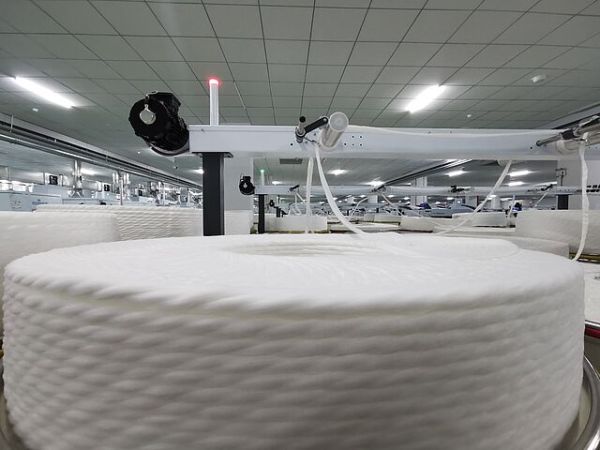“China Integrated Waste Management” project leverages additional resources to accelerate low-carbon development of the textile industry

Disclaimer: This news piece was authored by the NAMA Support Project (NSP) “China Integrated Waste Management”.
The NSP “China Integrated Waste Management” (IWM), implemented by the Deutsche Gesellschaft für Internationale Zusammenarbeit (GIZ) GmbH, supports five demonstration municipalities in optimising their waste management systems by applying best-available technologies and environmental practices. Recently, the project leveraged additional resources and conducted awareness-raising measures to accelerate the sustainable development of China’s textile industry in line with national policy initiatives.
The Suzhou Rural Commercial Bank (SZRCB) participated in trainings and other awareness-raising activities conducted by the NSP and approached the IWM team with the intention to apply the project’s methodology in the textile industry in Suzhou, in southern Jiangsu province, East China. After various rounds of fruitful exchange with the NSP, the Bank decided to provide funding for the “Textile Compass”, a new project launched jointly by the Shengze Town Government, Suzhou Finance Society, SZRCB and the GIZ in July 2022. In this new project, four of five project components of the NSP will be replicated for the context of textile industry in Shengze Town of Suzhou. These include technical assistance, analysis of greenhouse gas (GHG) emissions, capacity building and private sector mobilisation.
The Shengze Town of Suzhou is one of China’s silk capitals and a major traditional textile manufacturing town. However, textile production is associated with high climate and environmental impacts resulting from energy use, water consumption and industrial waste. The “Textile Compass” seeks to address both waste management and emissions reduction challenges in the textile sector by utilising the measuring, reporting and verification (MRV) methodology to calculate GHG emissions reduction developed by the China IWM NSP, as well as a new green financial instrument created by SZRCB. The latter incentivises local enterprises through low-interest loans to improve sustainability in textile production. With the support of the Shengze Government, the “Textile Compass” brings together businesses, financial institutions and policy makers to improve energy efficiency, optimise resource utilisation and lower GHG emissions of textile manufacturing processes.
The NSP also continues to raise awareness on the topic of textile waste among the Chinese public. On 24 March 2022, the NSP organised the “Waste to Fashion” live-streaming event with speakers from the start-up incubator and community of social entrepreneurs, Impact Hub Shanghai and the fashion brand, Bottloop, to present their innovative approaches to create a more sustainable fashion industry. The speakers shared their insights on the challenges to overcome in familiarising Chinese consumers with sustainable fashion and finding ways to “turn waste into treasure”. The event was publicly accessible and reached over 16,000 views on live streaming channels.
These measures align closely with efforts by Chinese policymakers to improve the sustainability of the textile industry. On 24 January 2022, the National Development and Reform Commission (NDRC), the Ministry of Commerce and the Ministry of Industry and Information Technology of the People’s Republic of China jointly issued the Implementation Advice on Accelerating the Recycling of Waste Textiles. In July 2022, NDRC selected 60 cities as pilots for further promoting recycling, including the recycling of textiles. Xi’an and Lanzhou, the demonstration municipalities of the NSP, are included in these 60 pilot cities, providing an opportunity to connect and anchor the NSP’s impact in the long-term. The NSP welcomes this progress in policy development and will continue supporting this process until the end of the NSP in October 2023.
“The textile industry is an important field of energy conservation and emissions reduction in Suzhou, with a large scale of capital investment” Wang Feng, Chief of Survey and Statistics Department of the People’s Bank of China
Visit the project’s official website [available in English] to learn more about it.
The NAMA Facility is a joint initiative of the German Federal Ministry for Economic Affairs and Climate Action (BMWK), UK’s Department for Business, Energy and Industrial Strategy (BEIS), the Danish Ministry of Climate, Energy and Utilities (KEFM), the Danish Ministry of Foreign Affairs (MFA), the European Union and the Children’s Investment Fund Foundation (CIFF).
